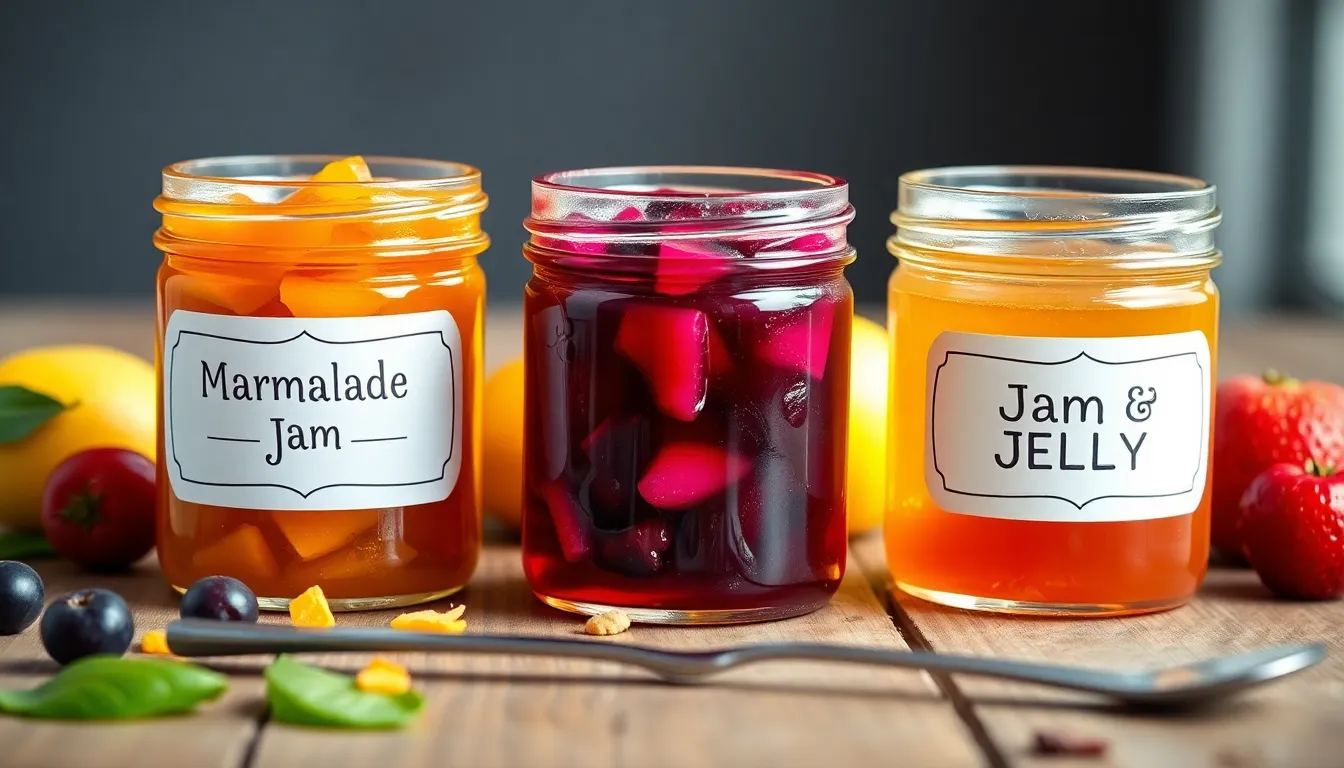When it comes to spreading joy on toast, the battle of the spreads gets serious. Marmalade, jam, and jelly might seem like just fruity friends, but they each bring their own unique flair to the breakfast table. Imagine a world where one spread reigns supreme—would it be the citrusy zing of marmalade, the chunky sweetness of jam, or the smooth elegance of jelly?
Table of Contents
ToggleOverview of Marmalade, Jam, and Jelly
Marmalade consists of citrus fruit preserves, typically made from oranges. It contains both fruit pulp and peel, giving it a unique texture and flavor. Jam, on the other hand, incorporates crushed fruits and is cooked down with sugar to create a thick consistency. Common fruits used in jam include strawberries, blueberries, and raspberries.
Jelly differs from both jam and marmalade since it is made from fruit juice rather than solid pieces of fruit. Often, jelly has a gelatin-like texture and can be derived from various fruits, such as grapes and cranberries. Each of these spreads has distinct qualities, appealing to different tastes.
Marmalade’s flavor profile highlights the bright, zesty notes of citrus, making it a strong contender for those who enjoy a refreshing taste. Jam offers a sweeter experience, reflecting the fresh flavors of the fruits used while preserving some of their texture. Jelly, being more refined, provides a smooth, sugary taste that works well in a variety of dishes.
In culinary contexts, marmalade tends to shine in breakfast applications, pairing excellently with toast or scones. Jam often complements pastries, ice creams, and desserts, enhancing their fruitiness. Jelly can serve as a versatile ingredient in glazes, marinades, and even savory dishes.
When deciding among these spreads, consider the desired texture, flavor, and use in recipes to choose the most suitable option. Understanding these key differences allows for better selection based on personal preference and dish requirements.
Key Differences Between Marmalade, Jam, and Jelly

Marmalade, jam, and jelly each feature unique ingredients and preparation methods.
Ingredients and Preparation
Marmalade consists primarily of citrus fruits, often using oranges, and includes both pulp and peel. It relies on sugar and pectin for its preservation process. Jam, on the other hand, incorporates crushed fruits and sugar, creating a sweet, thick mixture. Typically, it uses pectin but often requires less than marmalade. Jelly is made from fruit juice, water, and sugar, giving it a clear appearance. Additionally, jelly relies on pectin to achieve its gel-like consistency.
Texture and Consistency
Marmalade offers a chunky texture, with bits of fruit peel providing a distinct mouthfeel. Jam presents a thick and spreadable consistency, maintaining a fruity flavor while being sweeter. Jelly, in contrast, achieves a smooth, glossy texture, lacking any fruit pieces or pulp. This variety in texture plays a significant role in determining how each spread complements different dishes.
Nutritional Comparison
Marmalade, jam, and jelly differ significantly in nutritional content, especially in terms of sugar and calories.
Sugar Content
Marmalade contains approximately 50 grams of sugar per 100 grams, stemming from the citrus fruit and added sugar. Jam usually holds around 45 to 55 grams of sugar per 100 grams, derived from crushed fruit and sweeteners. Jelly, being made from fruit juice, mirrors this range with about 45 to 55 grams of sugar per 100 grams. The sugar content in all three spreads contributes to their sweetness, impacting their use in various culinary applications.
Caloric Value
Marmalade offers around 250 calories per 100 grams, making it a calorie-dense option among the spreads. Jam closely follows with approximately 250 to 300 calories per 100 grams, influenced by the level of sugar and fruit content. Jelly presents a slightly lower caloric value at around 200 to 250 calories per 100 grams. These caloric differences can guide choices for those monitoring dietary intake while selecting fruit spreads.
Popular Uses and Pairings
Marmalade, jam, and jelly shine in various culinary applications. Each spread complements specific dishes, enhancing flavors and creating delightful experiences.
Breakfast and Spreads
Marmalade complements toast and English muffins, adding a tangy zest. Jam enhances the flavor of pancakes and waffles with its sweet fruitiness. Jelly, known for its smooth texture, works well in sandwiches, especially peanut butter variations. Scones topped with marmalade offer a traditional breakfast treat. Bagels spread with cream cheese and jam provide a delightful morning option. Overall, these fruit spreads elevate breakfast dishes, adding variety and character.
Baking and Cooking
Marmalade serves as an excellent glaze for meats, providing a sweet and tangy finish. Jam can be swirled into yogurt or used as a filling in pastries, boosting sweetness and moisture. Jelly often finds its way into sauces and dressings, enriching flavors with its smooth consistency. Cookies that incorporate jam create a chewy and flavorful treat, appealing to many. Each spread offers versatility in baking and cooking, inviting creativity in meal preparation.
Choosing between marmalade jam and jelly ultimately depends on personal taste and culinary needs. Each spread offers unique flavors and textures that can enhance various dishes. Marmalade’s zesty notes add brightness to breakfast while jam’s sweetness complements desserts and pastries. Jelly’s smooth consistency provides versatility in both sweet and savory applications.
Understanding these differences allows for informed decisions when selecting the perfect spread. Whether it’s for a classic breakfast toast or an innovative recipe, each option brings something special to the table. Embracing the distinct qualities of marmalade jam and jelly can elevate any meal and inspire creativity in the kitchen.



